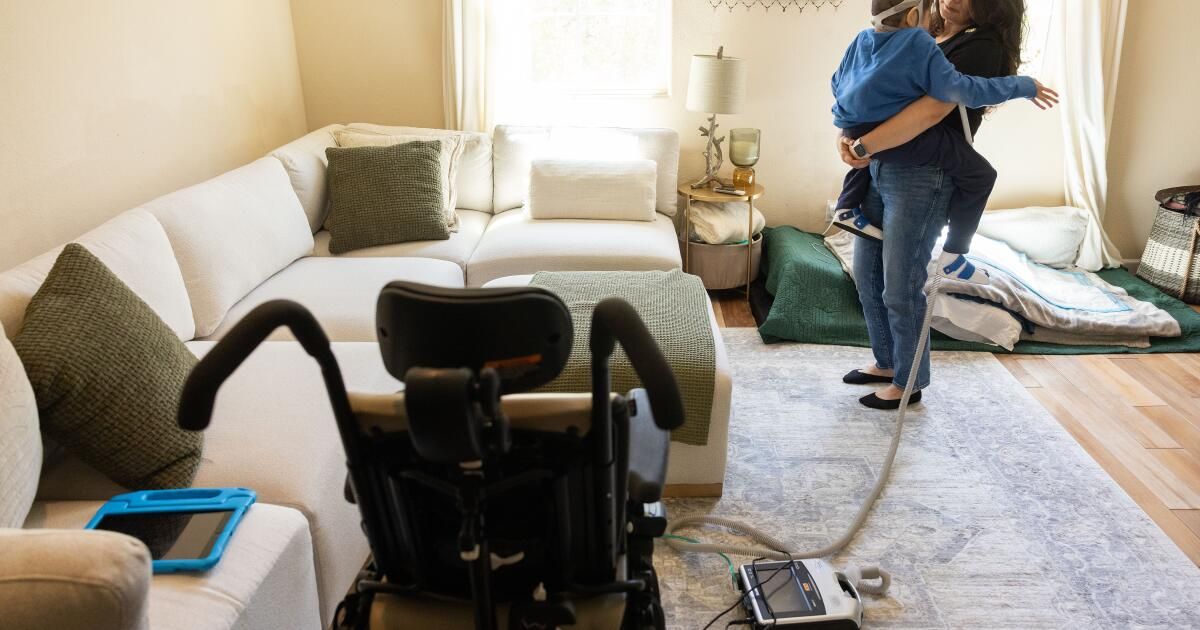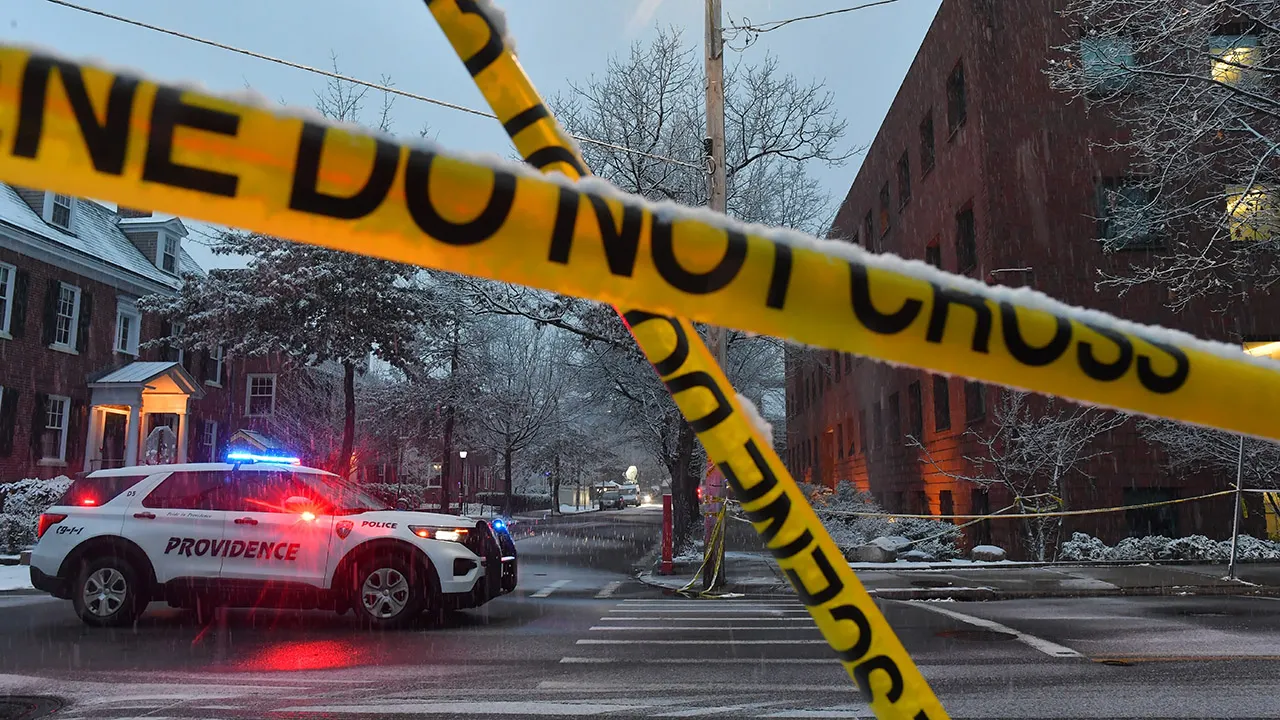Lyla Abuebaid needs to monitor her 5-year-old son at night to make sure he's still breathing.
Sayfideen suffers from a rare and severe syndrome that prevents him from walking. He is on a ventilator and must be monitored 24 hours a day, his mother said. In the past, nurses helped care for him at home.
But for months now, that job has fallen to her mother, who also combines her work as a project manager.
“I’m not functioning,” the San Jose resident said. “I’m not doing well at work. I’m not doing well at home.”
Abuebaid said he feels he has to “beg the state for services that he absolutely deserves.”
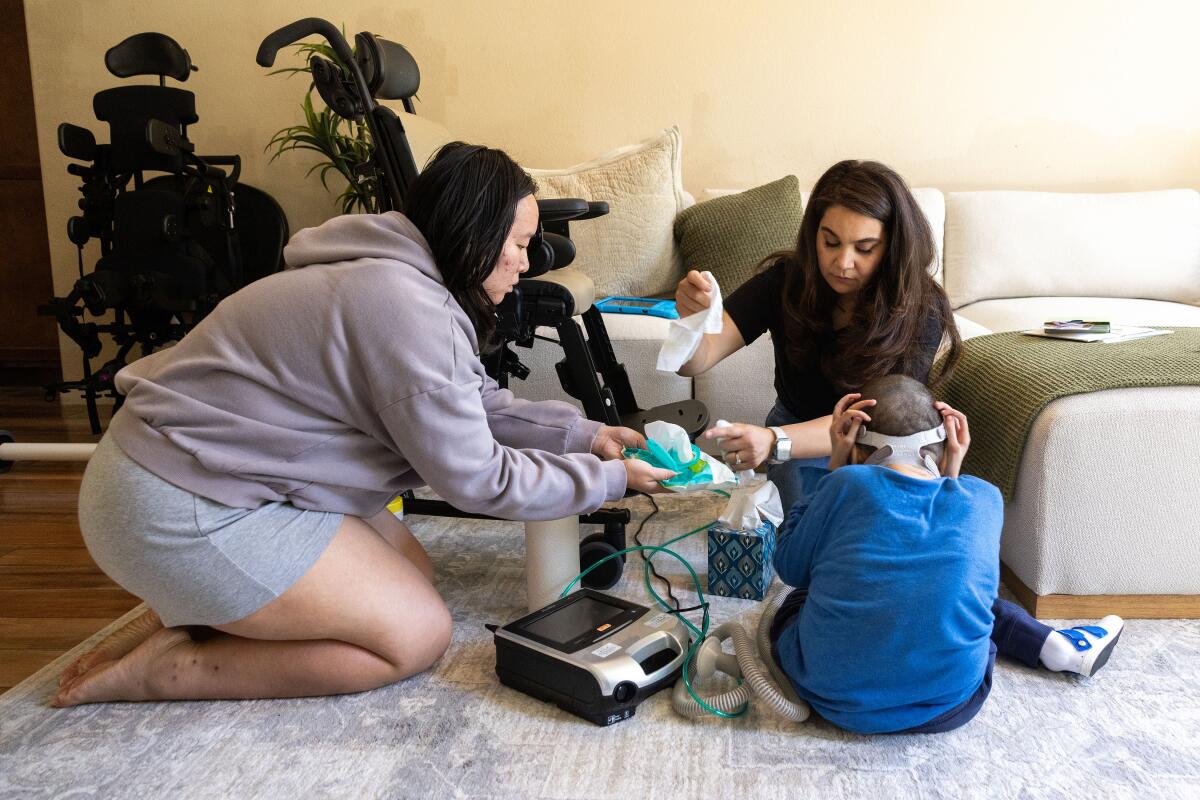

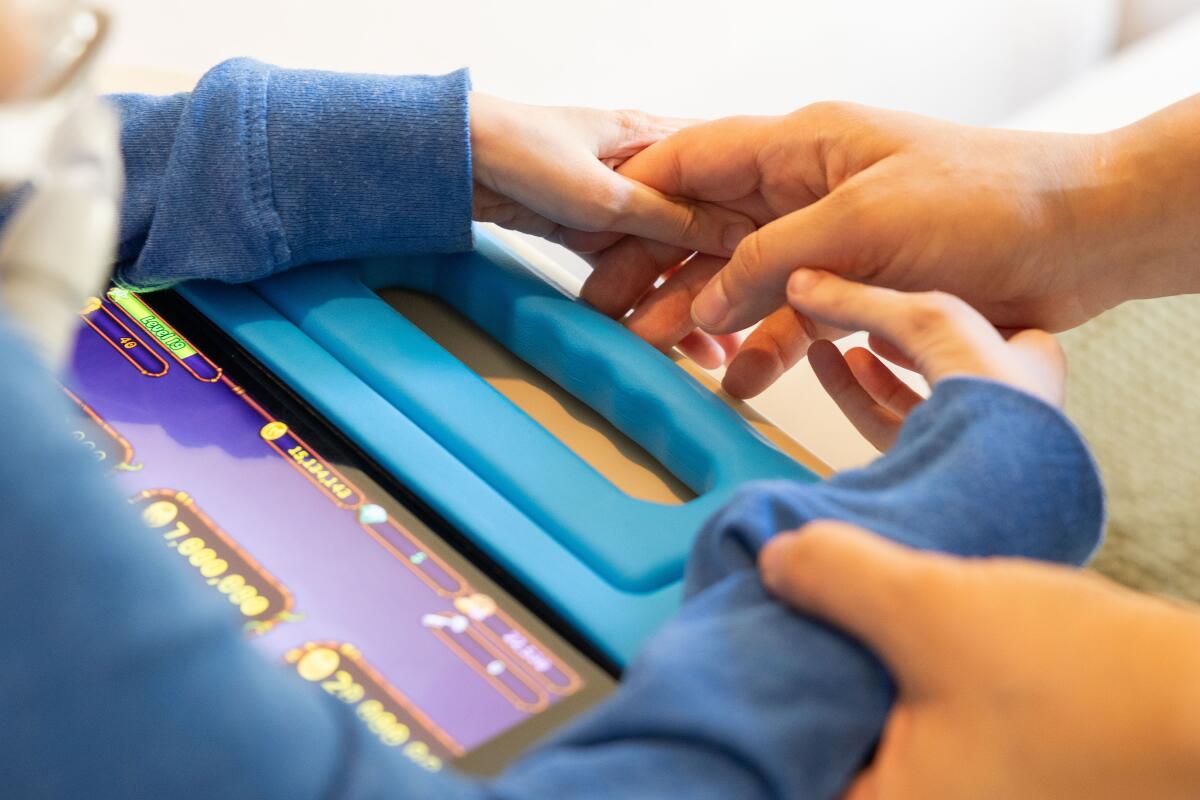
Lyla Abuebaid has been waiting for months for state help to care for her son. Sometimes she gets help from a family friend, but 5-year-old Sayfideen needs a full-time caregiver. (Peter DaSilva / For The Times)
She is among thousands of Californians who have been trying to obtain Medicaid benefits for services that help medically vulnerable people remain in their homes through the Home and Community-Based Alternatives waiver.
Demand for the HCBA waiver, which helps people who would otherwise have to live in nursing facilities, has far outstripped available spots. Last summer, California stopped accepting applications for the program after reaching an enrollment cap. Amid an outcry from disability rights advocates and families, California won federal approval to gradually add 7,200 spots over four years to eventually serve more than 16,000 people at a time.
Yet thousands of Californians remain on the waiting list. In June, more than 4,900 people were waiting, according to the Department of Health Care Services — more than double the number from last summer.
When people have to wait, either “seniors or people with disabilities who need services go without, or family caregivers have to fill the gaps,” said Nicole Jorwic, director of advocacy and campaigns for Caring Across Generations. Some may end up in nursing facilities “because there are just no alternatives.”
Disability rights advocates had warned the state last year that the planned increase in seats would not eliminate the years-long waiting list, let alone reach more Californians who might find themselves in need of care when faced with an unexpected illness or injury.
“I don’t know if they’ve done anything to address the problem,” said Clovis resident Sarah Scharnick, who first spoke to The Times about the waiting list last fall and is still on it. Her husband needs around-the-clock care, including being turned at night to prevent bedsores, after a bicycle accident.
Private insurers often don’t cover long hours of home nursing care, forcing many families to resort to placing their loved ones in nursing facilities or taking care of them themselves, advocates say. Abuebaid said her private insurance didn’t cover her son’s nursing care. She had previously received help through Medi-Cal, California’s Medicaid program, but then lost her coverage.
Paying for that care out of pocket “would bankrupt a millionaire,” said Katelyn Ashton, executive director of Loretta’s Little Miracles, which serves children with medical conditions. For many families who can’t qualify for the waiver, “their only option is to quit their job and provide that care themselves at home.”
State officials said that with the additional openings, nearly 10,800 people could participate in the program at one time this year. However, despite the demand for the program, more than 1,500 HCBA vacancies remained unfilled as of June, according to the health care services department.
The reason: The department said it is currently releasing only about 200 slots a month. Opening all the slots at once, it said, “would cause administrative delays” for both local agencies accepting applications and the state, “due to the sheer volume of applications to process.” The state agency said it has limited resources, “including staff, to review the existing volume of enrollment packets.”
The agency said it has seven nurses who review application packets (only two of whom work full time) and four other employees who help with the waiting list. DHCS said the process can also be delayed by scheduling difficulties at local agencies that receive applications.
The delay has alarmed groups like Disability Rights California and Justice in Aging. U.S. Rep. Nanette Barragán (D-San Pedro) said she has asked Gov. Gavin Newsom “to put the resources necessary to make sure that vacancies are filled as quickly as possible.”
“Including people in this program saves the state money in the long run,” he said.
State figures show that providing such care to a person at home is far less expensive than moving them into a nursing home: The Department of Health Care Services estimated in a May report that the average cost of a nursing facility is more than $134,000 a year, compared with about $53,000 for each person in the program.
“A lot of times we go a step further to get a dime,” said Jim Frazier, a former California Assembly member and public policy director for the Arc of California, which advocates for people with intellectual and developmental disabilities. “We don’t look at the long-term cost savings.”
The health department estimated that 40% of people who accessed the program were not from nursing homes, but “from the community.” Researchers have found that longer waits for these programs can be costly even if people don’t already live in institutions: In Iowa, older people were more likely to end up spending time in a nursing home within a few years if they had applied for such waivers when waits were long, researchers found.
According to advocates, the stalemate has also undermined efforts to help homeless people who are medically vulnerable. In the Bay Area, Cardea Health CEO Alexis Chettiar said the homeless clients her nonprofit serves “are too sick to live in unsupported housing, they are not allowed into shelters because they may be incontinent or have smelly wounds,” and nursing homes are often unwilling to take them in.
Instead, her nonprofit has worked to enroll them in the HCBA program while they are housed. The group said it has saved more than $7 million annually by reducing emergency room visits, hospitalizations and other medical costs for those patients.
“It really works,” Chettiar said. “Or should I say it worked great until we hit the limit.”
More than 90 of her clients are now on the waitlist, where some have been on hold for more than a year and a half. Cardea Health has been footing the bill for their care, but Chettiar said it can’t do that forever — it has relied on a few years of “seed funding” from local governments when it begins providing services at a site, but had planned to put patients on the HCBA waiver for continued care.
As California releases slots, it has been prioritizing people under 21, as well as people who have already been stuck for months in health care facilities, among others. DHCS said opening up slots month by month has allowed it to continually ensure those applications get to the front of the line. Abuebaid said that after months of waiting, she had recently been scheduled for an intake appointment for her son.
For Californians who don’t meet those criteria, however, the waits can be especially tough. In June, more than 90% of those on the HCBA waitlist were not in priority groups, according to the state.
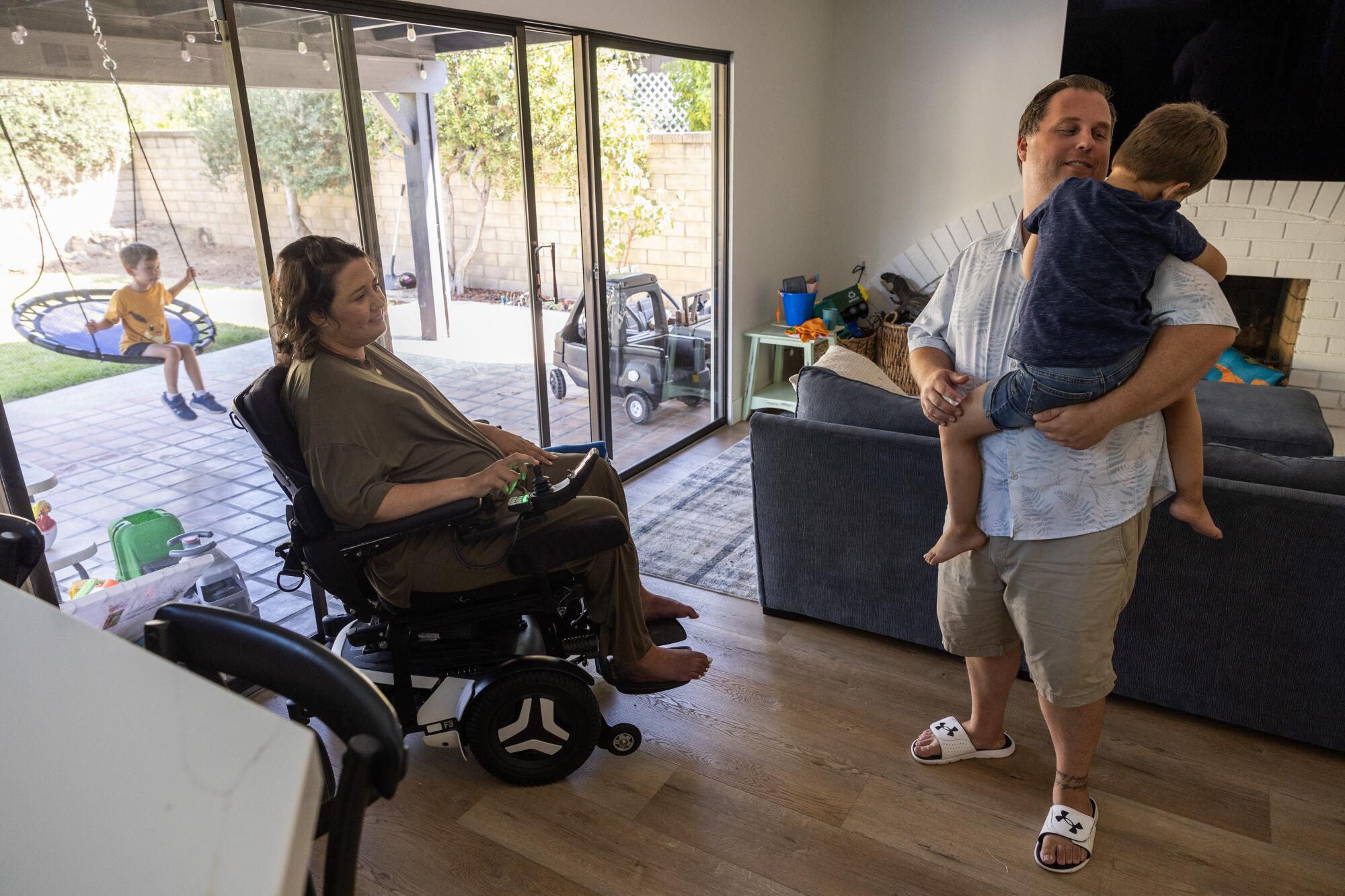
Jenina Marik has ALS. The family applied through the state for home care nearly a year ago, and her husband, Tyler Marik, fears he may have to stop working to focus on caring for others.
(Myung J. Chun / Los Angeles Times)
Among them is Jenina Marik, who was diagnosed with amyotrophic lateral sclerosis (ALS) about a year and a half ago. In just a few years, the 40-year-old from Valencia went from running half marathons, running her wedding photography business and caring for her young children to being unable to feed or dress herself.
Her husband, Tyler Marik, turned to a care service to help her while he went to work, but “I was broke.” After months of struggling, the family finally received help through a government home care program, but “it’s not enough.”
Because Jenina, now a quadriplegic, still requires around-the-clock care, “I sleep maybe five hours a night… And when I'm tired that can compromise her safety,” Tyler Marik said.
The HCBA waiver could allow them to receive more care, but it's been almost a year since they applied for it. Marik fears he may have to stop working if nothing changes. Moving his wife to a facility “would be a nightmare,” he said.
“That would be even worse than ALS.”
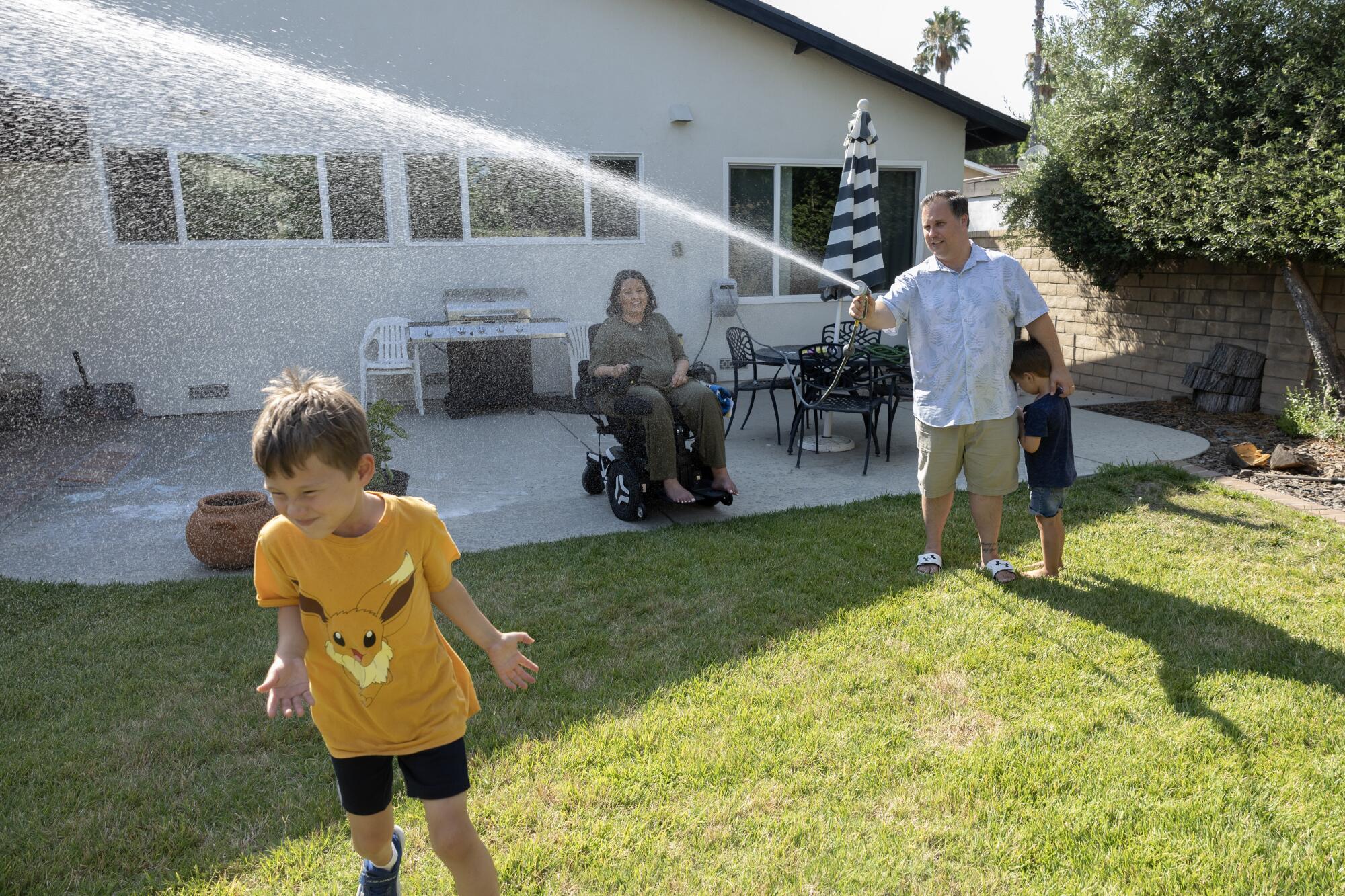
Eli Marik, 7, cools off in the backyard with his father Tyler, brother Owen, 4, and mother Jenina.
(Myung J. Chun / Los Angeles Times)

